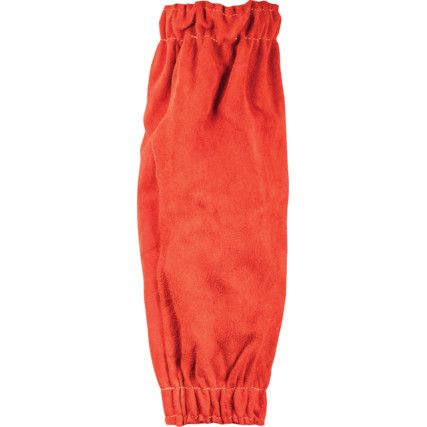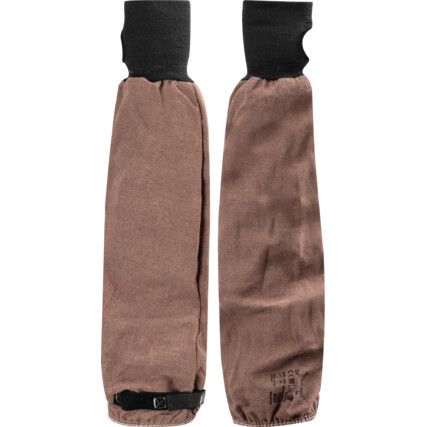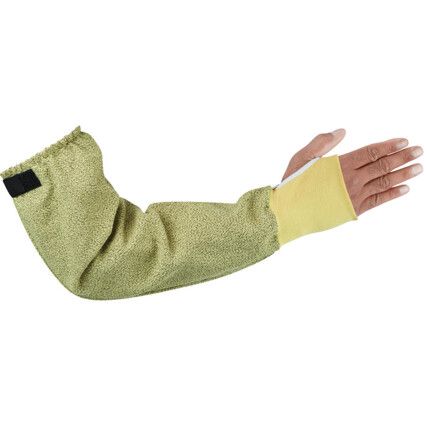Welding Sleeves
Take a look at our selection of welding sleeves at Cromwell.co.uk. We stock an excellent choice of sleeves from well-known and reliable brands, like Ansell® and our own brand Kennedy®.
What are welding sleeves?
Welding sleeves deliver lightweight and breathable arm protection to welders. Constructed from fire-retardant material, such as Kevlar®, welding sleeves are designed to shield the arm, either from the wrist to the elbow or from the wrist to the upper arm, against sparks and spattered molten metal.
Why welding sleeves?
When working in extreme levels of heat, a welding jacket can become too uncomfortable to do the job. Flame-retardant t-shirts in both long and short-sleeved variants are a good alternative to a welding jacket or coverall, as too are lightweight welding sleeves.
Welding sleeves vary in their levels of protection, but most shield the skin from high heat, sparks and flying particles of molten metal.
When welding sleeves?
In all types of welding environments and application types it is vital to wear welding sleeves to ensure you are fully protect from extreme heat, burn accidents and injuries.
Welding sleeve types
Welding sleeves are made from a range of materials and in a wide selection of designs. Different types of welding and some cutting applications pose different levels of risk, and its important that the right safety sleeve is chosen for the task. All welding sleeves should be CE marked and be compliant to EN ISO 11611 standards.
• Cotton - Lightweight and moisture-wicking, cotton welding sleeves are widely used when working in excessive heat. Cotton can be laundered, and, while it offers the lowest levels of protection in comparison to other materials, it's still effective against sparks and unexpected bursts of flame.
• Kevlar® - Extremely strong and heat resistant, Kevlar® has a multitude of uses. A synthetic material, sleeves made from it are lightweight and suitable for laundering without losing shape or protection.
• Leather - The traditional choice for protective welding clothes, split cowhide leather is extremely durable with heat and flame resistance. It can't be laundered in the same way as cotton or Kevlar®, but can be regularly brushed for maintenance.
• Combination - Welding sleeves made with a combination of materials can deliver a more resistant and durable product. For example, Kevlar® stitching is frequently used on fire-retardant PPE for its excellent resistance to heat and flame. A combination leather and Kevlar® welding sleeve delivers the high levels of protection but reduces the weight and increases breathability for the wearer's comfort. For lighter welding work, a Kevlar® sleeve lined with cotton delivers lightweight, reliable protection.
Considerations when choosing welding sleeves
• Welding type - the type of welding (MIG, TIG or Arc) will define the levels of protection required from a welding sleeve.
• Length - welding sleeves can cover just the forearm (with some versions extending over the wrist and thumb), while others cover the entire arm.
• Material - sleeve construction delivers different benefits and levels of protection depending on the material used. Cotton sleeves offer the least protection, while Kevlar®, leather and combination sleeves offer the highest.
• Fit - Some welding sleeves can rely on elasticated ends for a secure fit, while others feature hook and loop closures that can be adjusted to the size of the arm.
• Other PPE - when using a welding sleeve in conjunction with other types of PPE such as gloves, and a t-shirt or sweater, make sure that you receive the right amount of coverage during use: that the safety wear works well together and doesn't hinder your protection.
Welding sleeve jargon buster
With a wide range of welding PPE on the market, safety compliance can get tricky. To help you understand the applications of our range a little better, we've broken down and explained a safety standard for welding sleeves and gloves.
What does the thermal protection standard EN ISO 11611:2015 mean?
EN ISO 11611:2015 replaces EN 407-1, and covers all protective clothing used in welding or similar processes. This standard defines an item of welding PPE according risk: Welding tasks that produce low spatter and radiant heat (Class 1), or higher risk welding that produces high levels of spatter and radiant heat (Class 2).
Let's break it down...
• EN - This is a current European standard
• ISO - The International Organisation for Standardisation
• 11611 - This is the assigned legislation number
• 2015 - This is the year the safety standard was updated
• Class 1 - Low risk welding techniques with low level sparks, spatter, and radiant heat
• Class 2 - High risk welding techniques with high levels of sparks, spatter, and radiant heat
FAQs
Can you wash leather welding sleeves?
Never apply water directly to leather welding clothing as this can damage the fibres. Instead, with a lightly moistened cloth and a bit of saddle soap gently scrub in circular motions. Rinse and repeat with the lightly moistened cloth until the area is clean.
Then using a clean, very lightly moistened cloth wipe away the excess saddle soap. Ensure that you don't allow the soap to dry on the sleeve during cleaning, wipe it away with a clean moistened cloth.
Once the sleeve is clean, apply a leave-in leather conditioner with a clean, dry cloth to keep the leather soft and flexible.
Which is better, a welding jacket or welding sleeves?
The answer to this question depends on several factors: the type of welding application, the level of risk and the environment. A class 2 welding sleeve and a class 2 welding jacket both provide protection against high-risk welding techniques. A welding jacket provides reliable coverage; however, it can also be heavy and cumbersome in high heat environments. A welding sleeve is lightweight and breathable but can leave gaps between clothing that exposes the skin. Most professional welders switch between a sleeve and a jacket at different times to ensure optimum comfort and protection.
For more information on welding sleeves see our Flame Retardant Workwear Guide... https://www.cromwell.co.uk/info/safety-technical-flame-retardant-workwear


